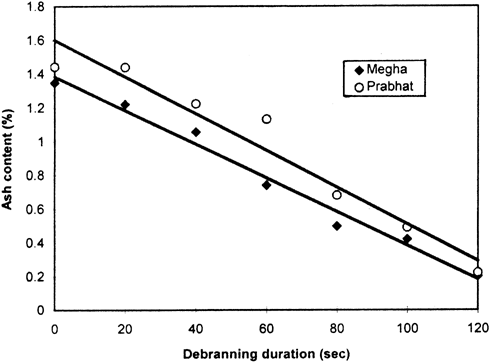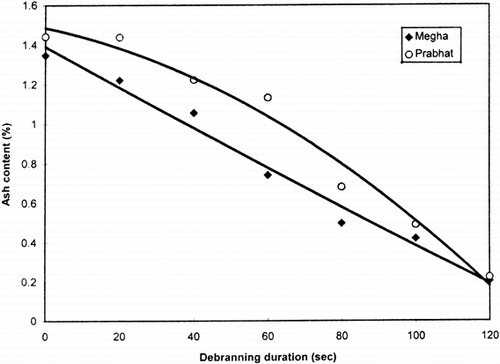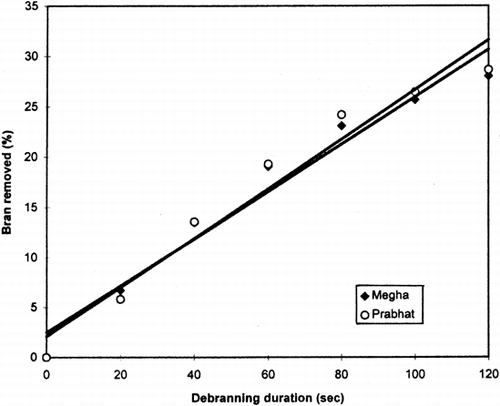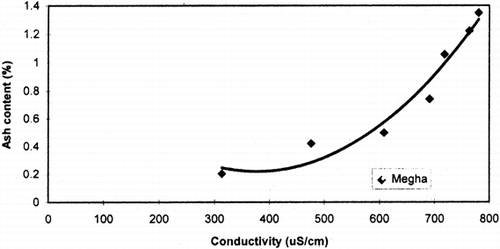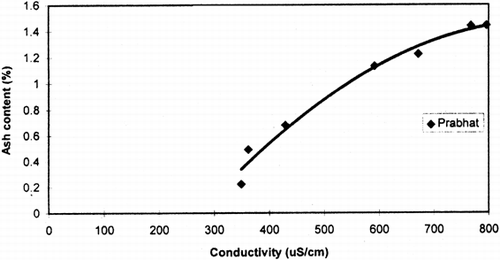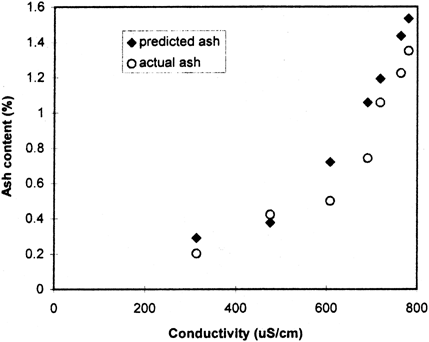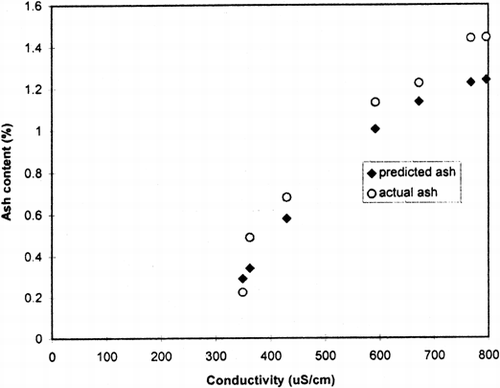Abstract
Two Indian flint maize cultivars were evaluated for ash distribution pattern using a McGill No. 2 miller. Both the maize cultivars was debranned for 20, 40, 60, 80, 100 and 120 s and determined for percent bran removed, ash content and conductivity. The regression equations were computed to determine the relationship between bran removed versus debranning duration, ash content versus debranning duration and ash content versus conductivity. The maize cultivars differ significantly with respect to percentage loss of ash content at various debranning stages. Parbhat cultivars showed lower loss of ash as compared to Megha under similar stages of debranning. The quadratic regression model for the relationship between ash content and conductivity of solubles extracted from maize grain debranned for different intervals had a high coefficient of determination (0.959 0.979). This indicated that the computed models can be used to determine percent bran removed from debranning duration and ash content from the conductivity.
Keywords:
INTRODUCTION
In the dry milling of maize debranning is carried out by subjecting the kernels to abrasive or friction pressure to remove pericarp (bran), germ and tip cap which constitute 83% of ash content of whole kernel. The endosperm after debranning is milled into the desired degree of fineness to obtain corn grit, corn flour etc. The removal of pericap, tip cap and germ is essential because these fractions are high in fiber, ash and oil which lowers the appearance and digestibility of the milled fraction. Ash content of milled fraction indicates how completely and efficiently the endosperm has been separated from pericarp, germ and tip cap. The determination of ash content in wheat and brown rice based on conductivity is a quick and alternate method to the routinely used method based on measurement of oxidized residue remaining after incineration at higher (600°C) temperature for 5–6 h Citation1-2.
The objectives of the present research were to: i) evaluate the performance of McGill Miller No. 2 by correlating debranning duration to percent bran removed and ash content of maize cultivars, and ii) establish the relationship between the ash content and conductivity of solubles extracted from maize cultivars.
MATERIALS AND METHODS
Maize Samples
Two flint maize cultivars Prabhat and Megha were collected from Punjab Agriculture University from 1998–99 harvest and had moisture content in the range of 11–13%.
Debranning
The maize kernels (150 g) were debranned after adding calculated amounts of water to raise the moisture content to 14% in triplicate for 20, 40, 60, 80, 100 and 120 s in the McGill Miller No. 2 rice miller (Rapsco, Brookshire, TX, USA) equipped with an automatic timer. The pressure on the maize during debranning was controlled by placing a weight (660 g) on the mill lever arm. The weight was placed at a distance of 21.5 cm from the center of the saddle to the center of weight. The miller was thoroughly cleaned after each milling interval by brushing the bran from screen and rotor.
Analysis
The maize samples debranned for different duration were ground to pass through 50 mesh sieve and analysed for ash content and conductivity. The ash content of all samples was determined using AACC method Citation[3]. The accuracy of the ash content determinations was ±0.04–0.06%. Each sample (2 g, 14% mb) was dispersed with 25 ml of deionized water for 30 min at 25°C with stirring after every 5 min. The material was then centrifuged at 4000 g for 5 min and the supernatant was collected and analysed for conductivity. The conductivity was measured with a digital conductivity meter (Model CM-183, EC-TDS Analyser Elico Pvt Ltd., Hyderabad). A dip type cell with cell constant 1.0 was used in all the measurements. The accuracy of the conductance measurements was ±0.5%. The data reported for ash content and conductivity are an average of three observations.
RESULTS AND DISCUSSION
Relation Between Ash Content and Debranning Duration
Both the maize cultivars differ significant in ash content. Prabhat showed highest ash content of 1.44% against a value of 1.35% for Megha. Figure illustrates the effect of debranning duration on ash content in both the maize cultivars. The ash content decreased with the increase in debranning duration in both the cultivars. For Prabhat the ash content after 20, 60 and 120 s of debranning were 1.44, 1.13 and 0.22% respectively. While the ash content for Megha were 1.222, 0.742 and 0.203% at corresponding debranning duration. Debranning for 20, 60 and 120 s resulted into a loss in ash content of 0.208, 21.5 and 84.5%, respectively, for Prabhat against a loss of 9.4, 45 and 85% under similar conditions for Megha. Megha cultivar showed higher loss of ash as compared to Prabhat at different debranning stages. The relationship between the ash content (Y) and debranning duration (X) for Megha and Prabhat is shown in the linear regression Equations Equation1 and Equation2.
Ash content was inversely related to debranning duration in both the maize cultivars with r 2 value of 0.983 for Megha and 0.947 for Prabhat. Megha changed more in ash content after each successive debranning interval than did Prabhat. The percentage loss of ash increased with increase in removal of bran in both the cultivars. A higher concentration of ash in the fractions removed during debranning of maize than in endosperm is well reported Citation[4]. The ash distribution in maize kernels has been reported as 0.8% in pericarp (bran), 10.5% in germ, 1.6% in tip cap and 0.3% in endosperm Citation[4].
The relationship between ash content (Y) and debranning duration (X) for Megha and Prabhat can also be explained using quadratic Equations Equation3 and Equation4, respectively.
Figure shows the quadratic relationship between ash content and debranning duration with r 2 value of 0.983 for Megha and 0.978 for Prabhat.
Relationship Between Debranning Duration and Percent Bran Removed
Figure illustrates the effect of debranning duration on percent bran removed in both the maize cultivars. Debranning for 20, 60 and 120 s caused a removal of bran by 5.8, 19.3 and 28.6%, respectively, in Prabhat and 6.72, 19.1 and 28% under similar conditions in Megha. The regression analysis was performed to determine the relationship between debranning duration and percent bran removed in both the maize cultivars. The relationship between per cent bran removed (Y) and debranning duration (X) for Megha and Prabhat is shown in Equations Equation5 and Equation6, respectively.
The coefficient of determination for both the equations was sufficiently high, 0.959 for Megha and 0.958 for Prabhat. The percent bran removed at successive milling intervals did not differ significantly in both the maize cultivars. This showed that both the maize cultivars were almost same with respect to hardness. The relationship between percent bran removed (Y) and debranning duration (X) can also be explained for Megha and Prabhat using quadratic Equations Equation7 and Equation8.
The quadratic relationship between percent bran removed and debranning duration with r 2 value of more than 0.99 in both the maize cultivars.
Relationship Between Ash Content and Conductivity
The relationship between ash content (Y) and conductivity (X) of solubles extracted from Megha and Prabhat cultivars debranned for different intervals can be expressed using linear regression Equations Equation9 and Equation10, respectively.
The r 2 values for both the equations represent the proportion of variablity in the data accounted for by the equation. The r 2 values for Megha and Prabhat for the relationship between ash content and conductivity of solubles were in the range of 0.844 and 0.955, respectively. The r 2 values revealed that most of the variability in conductivity had been accounted for by the ash content in both the cultivars. The conductivity of solubles extracted from both the cultivars showed a linear relationship with ash content.
The relationship between percent ash content (Y) and conductivity (X) can be explained for Megha and Prabhat using quadratic Equations Equation11 and Equation12.
The r 2 values for both the cultivars for the relationship between ash content and conductivity of solubles were in the range of 0.955 and 0.979. Figures and indicate strong quadratic relationship between conductivity and ash content. Therefore, by determining the conductivity, the ash content can be predicted by quadratic regression. To test the accuracy of these regression equations, the ash content was predicted using Equations Equation11-12 and percentage error was calculated using following expression:
The average error of predicted ash content from Equations Equation11 and Equation12 were −0.232 and 0.088%, in Megha and Prabhat, respectively.
CONCLUSION
Both the maize cultivars differ significantly with respect to ash distribution pattern during different debranning intervals. Ash content in maize kernels debranned for different debranning intervals showed a linear as well as quadratic relationship with conductivity. However, quadratic regression equation between ash content and conductivity showed greater r 2. The statistical models developed in the present study can be used to determine ash content by measuring conductivity. The models can also help in predicting the debranning duration required to remove the desired amount of bran. The results obtained in the present study are based on two flint maize cultivars using laboratory McGill No. 2 miller. Further studies are required on different maize cultivars using commercial milling machines.
Acknowledgments
REFERENCES
- Singh , N. , Singh , H. and Bakshi , M. S. 1998 . Determining the Distribution of Ash in Wheat Using Debranning and Conductivity . Food Chemistry , 62 : 169 – 172 .
- Singh , N. , Singh , H. , Kaur and Bakshi , M. S. 2000 . Relationship Between Degree of Milling, Ash Distribution Pattern and Conductivity in Brown Rice . Food Chemistry , 69 : 147 – 151 .
- 1995 . “ American Association of Cereal Chemist ” . In Approved Methods of the AACC , 9th ed. St. Paul, MN : The Association . Method 08–01
- Watson , S. A. 1991 . “ Structure and Composition ” . In Corn Chemistry and Technology Edited by: Watson , S. A. 53 – 82 . St. Paul : AACC .
